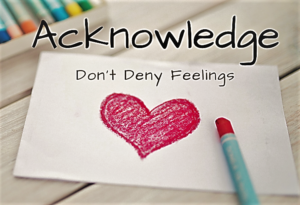
It is normal to feel a wide array of emotions: scared, happy, nervous, sad, disappointed, mad. As empathetic human beings, a helpful goal is to meet people in their emotional experience rather than try to take away what they’re feeling.
A developmental theorist, Robert Kegan, wrote about how parents have the opportunity to respond to children when they’re experiencing anxiety. A parent’s response either teaches a child that anxiety is a normal or not normal experience. He wrote “when a mother responds to [her child’s] anxiety with the intention to relieve it […]she contributes to the feeling that the anxiety is ‘not-me’ or an alien experience” (Kegan, p125). Summarized, if we try to take away someone’s feeling (if we try to relieve it), we’re subtly informing them that this feeling is not normal and needs to be avoided.
What should we do instead? The healthier approach is to allow a child to experience their feeling, without the intention of taking it away. By giving the child the chance to feel sad, you’re letting them know that you’re confident that this feeling is normal and that it’s something that isn’t so concerning it needs to be avoided.
So how does this play out?
A child is scared of the dark:
- Avoid Feeling Response: “Don’t feel scared, monsters aren’t real” (even if the child knows monsters aren’t real, their fear is real and can be acknowledged)
- Acknowledge Feelings Response: “It’s hard to be scared at night. Even though we’ve talked about how monsters aren’t real, I can tell you’re feeling nervous.”
- Problem Solve: “What can we do to help you feel less nervous?”
A child is crying about their dad leaving for work.
- Avoid Feeling Response: “There’s nothing to be sad about”
- Acknowledge Feelings Response: “I can tell you’re feeling sad about dad going to work”
- Problem Solve: “What would help your sad feeling?”
A child is scared after getting lost in a store
- Avoid Feeling Response: “Don’t cry. I’m here. Nothing can go wrong if I’m here” (this isn’t true)
- Acknowledge Feelings Response: “That felt a little scary when I couldn’t find you. Are you feeling a little scared too? I’m glad we found each other. How are you feeling now after we found each other?”
- Problem Solve: “What could help you feel less scared?”
Pro Tips:
- Sometimes distraction may be used dependent on the level of the feeling/injury. Often though, distraction becomes a form of avoidance.
- You’re sad? Lets buy that doll you wanted.
- You’re angry? Would McDonalds make you happy?
- You’re nervous? Lets watch a movie so we don’t have to think about it.
- Crouch or kneel down to their level
- When you ask them to problem solve or meet the need they may need some help. It may work to give them a few ideas (at least one of which is silly) and have them choose.
- Instead of breaking it down into acknowledge and problem solve you can address the problem based on the feeling, what the feeling means, and how to meet that need (this works better for older kids)
- What am I feeling?
- Feeling: I feel sad.
- What is the feeling trying to communicate? What do I need?
- Need: Sadness is communicating loneliness because my friend went on a trip and I’m alone.
- How can I meet that need?
- Meet the need: Ask a parent or sibling for a hug. Write a letter to the friend. Think of some fun memories you’ve had with the friend. Problem solve some ways to have fun even though your friend is not here.
Kegan, R. (1982). The Evolving Self: Problem and Process in Human Development. Cambridge, MA: Harvard University Press.
